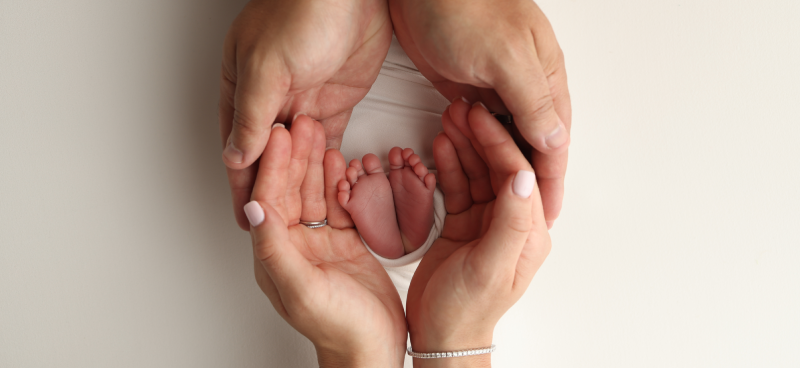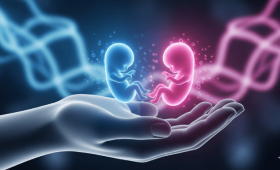In Vitro Fertilization (IVF) stands as a landmark achievement in modern medicine, offering a beacon of hope to millions of couples worldwide facing the challenge of infertility. More than just a single procedure, IVF is a sophisticated series of steps designed to help build families where nature needs a helping hand. This comprehensive guide will walk you through the entire IVF journey, from the initial consultation to the science of success, and delve into the advanced and often-debated topic of gender selection.
Understanding IVF: The Science of New Beginnings
At its core, In-Vitro Fertilization is an advanced Assisted Reproductive Technology (ART) where an egg is fertilized by a sperm outside the body, in a controlled laboratory setting (“in vitro”). The resulting embryo is then carefully nurtured before being transferred into the woman’s uterus, with the hope of achieving a successful pregnancy. The fundamental principle is to overcome natural barriers that may prevent the egg and sperm from meeting, allowing fertilization and early embryonic development to occur under ideal conditions.
The process is a meticulously orchestrated sequence of medical procedures, each timed to maximize the chances of success. It begins with stimulating the ovaries, followed by egg retrieval, fertilization, embryo culture, and finally, the transfer of the embryo back to the uterus. Once a successful implantation occurs, a pregnancy achieved through IVF is biologically identical to one conceived naturally.
Who is a Candidate for IVF?
IVF has evolved from a solution for a specific problem—blocked fallopian tubes—into a versatile platform technology that addresses a wide spectrum of reproductive challenges.
Common Reasons for Seeking IVF:
- Tubal Factor Infertility: Damaged, blocked, or absent fallopian tubes are one of the most common reasons for IVF, as they physically prevent the egg and sperm from meeting.
- Ovulation Disorders: Conditions like Polycystic Ovary Syndrome (PCOS) that cause irregular or absent ovulation can be overcome with IVF.
- Endometriosis: This condition, where uterine-like tissue grows outside the uterus, can impair fertility. IVF is often a successful option for these patients.
- Male-Factor Infertility: Low sperm count, poor motility, or abnormal sperm shape can make natural conception difficult. IVF, especially when combined with Intracytoplasmic Sperm Injection (ICSI), can bypass these issues. In cases of zero sperm count (azoospermia), sperm can often be retrieved surgically from the testes and used for ICSI.
- Advanced Maternal Age: A woman’s fertility naturally declines after the age of 35 as egg quantity and quality decrease. IVF is often the most effective treatment for women in this age group.
- Unexplained Infertility: When no specific cause for infertility can be found after extensive testing, IVF often provides a successful path to pregnancy.
- Preimplantation Genetic Testing (PGT): For couples with a known risk of passing on a genetic disease, PGT allows for the screening of embryos before transfer, increasing the chance of a healthy baby.
- Fertility Preservation: Individuals facing medical treatments like chemotherapy, which can harm fertility, can freeze their eggs or embryos for future use.
The IVF Journey: A Step-by-Step Guide
The IVF process is a journey that typically spans 15-20 days for a single cycle, but it requires careful planning and coordination.
1. Initial Consultation and Personalized Planning The journey begins with a comprehensive evaluation of both partners’ medical history. For the female partner, this includes a transvaginal ultrasound to assess the uterus and ovaries, and blood tests to measure key hormones like AMH and FSH. For the male partner, a semen analysis is the cornerstone of evaluation. Based on these results, a personalized treatment protocol is created, tailoring medication types and dosages to the patient’s specific needs.
2. Ovarian Stimulation The goal of this phase is to use hormonal medications (gonadotropins) to stimulate the ovaries to produce multiple mature eggs, rather than the single egg typical of a natural cycle. More eggs lead to more embryos, which increases the chance of selecting a high-quality one for transfer. This phase lasts about 8-12 days and involves regular monitoring through ultrasounds and blood tests. Once the follicles (egg-containing sacs) reach the optimal size, a final “trigger shot” is administered to induce final maturation.
3. Egg Retrieval (OPU) Precisely 34-36 hours after the trigger shot, the eggs are collected in a minor surgical procedure called Oocyte Pick-Up (OPU). Performed under light anesthesia, the procedure is painless and takes about 15-30 minutes. Using ultrasound guidance, a thin needle is passed through the vaginal wall into the ovaries to gently aspirate the fluid from each follicle. This fluid is immediately passed to the embryology lab, where the eggs are identified and prepared for fertilization.
4. Fertilization and Embryo Culture On the same day as the egg retrieval, a sperm sample is collected and prepared. Fertilization is then achieved through one of two methods:
- Conventional IVF: The eggs and sperm are placed together in a petri dish to allow fertilization to occur naturally.
- Intracytoplasmic Sperm Injection (ICSI): An embryologist selects a single, healthy sperm and injects it directly into the egg. This technique has revolutionized the treatment of male infertility and is now widely used even in other cases to maximize fertilization rates.
Once fertilized, the resulting embryos are cultured in a specialized incubator that mimics the uterine environment for 3 to 5 days.
5. Embryo Transfer This is the final, delicate step of the IVF cycle. The highest-quality embryo (or embryos) is selected and transferred into the uterus using a thin, soft catheter. The procedure is typically painless and does not require anesthesia. The number of embryos transferred is often regulated to minimize the risk of high-order multiple pregnancies. In Turkey, for example, women under 35 are typically limited to a single embryo transfer for their first two attempts.
6. The Two-Week Wait and Pregnancy Test Following the transfer, the patient will take progesterone supplements to support the uterine lining and a potential pregnancy. Approximately 9 to 14 days after the transfer, a blood test is performed to measure the level of the pregnancy hormone, beta-hCG. A positive test is confirmed with a second test 48 hours later to ensure the hormone levels are rising appropriately, indicating a healthy, developing pregnancy.
Factors for IVF Success
The outcome of an IVF cycle depends on a complex interplay of factors.
- Woman’s Age: This is the single most important determinant of success. As a woman ages, particularly after 35, the quantity and quality of her eggs decline, which can lead to lower success rates and a higher risk of miscarriage.
- Embryo Quality: The viability of the embryo is crucial. High-quality embryos, resulting from good quality eggs and sperm, have a better chance of implanting.
- Uterine Health: The receptivity of the uterus is just as important as the embryo. Issues like fibroids, polyps, or a thin uterine lining can prevent implantation.
- Lifestyle Factors: A healthy lifestyle can significantly impact success. Maintaining a healthy weight, avoiding smoking and excessive alcohol, and managing stress are all beneficial.
- Clinic and Laboratory Expertise: The experience of the clinical team and the quality of the embryology lab play a vital role. Advanced technologies and skilled embryologists can greatly improve outcomes.
Success Rates at a Glance
IVF success is typically measured by the “live birth rate” per cycle. These rates vary significantly by age:
- Under 35: ~50-60%
- 35-37: ~40-47%
- 38-40: ~20-30%
- Over 40: Success rates drop significantly, often to less than 15% per cycle.
Gender Selection: The Science, Legality, and Ethics
One of the most advanced and controversial applications of IVF technology is the ability to select the gender of a child before pregnancy.
The Science: Preimplantation Genetic Testing (PGT) The only scientifically valid method for gender selection is Preimplantation Genetic Testing (PGT), performed in conjunction with an IVF cycle. After embryos are created, a few cells are biopsied from each one at the blastocyst stage (day 5 or 6). These cells are then analyzed to determine their chromosomal makeup, including the sex chromosomes (XX for female, XY for male). This allows for the selection of chromosomally normal embryos of the desired gender for transfer, with an accuracy rate of over 99%.
The Legal and Ethical Landscape The legality of non-medical gender selection varies dramatically around the world. In many countries, including Turkey, it is strictly prohibited for social reasons like “family balancing”. The only exception is when there is a medical necessity to prevent the transmission of a serious sex-linked genetic disease, such as hemophilia or Duchenne muscular dystrophy.
However, in other regions, such as the Turkish Republic of Northern Cyprus (TRNC), the United States, and Dubai, non-medical gender selection is legally permitted. This legal disparity has led to the rise of “fertility tourism,” where couples travel to countries where the procedure is available.
This practice sparks intense ethical debate. Opponents raise concerns about gender discrimination, the potential for a “slippery slope” toward “designer babies,” and the commodification of children. Proponents argue for reproductive autonomy, allowing parents to make decisions about their family structure, a concept often referred to as “family balancing”.
Your Journey with Cure Holiday
Navigating the world of IVF and gender selection can be complex and overwhelming. At Cure Holiday, we understand the intricacies of this journey and are dedicated to providing clear, compassionate guidance. We partner with some of the most successful and technologically advanced clinics in Cyprus, a leading destination for high-quality IVF and legal gender selection procedures. Our experienced partners utilize state-of-the-art technology and personalized care to help you achieve your dream of building a family.
If you are considering IVF or wish to learn more about the possibility of gender selection, we are here to help. Contact us for detailed, free information and let us support you on your path to parenthood.



